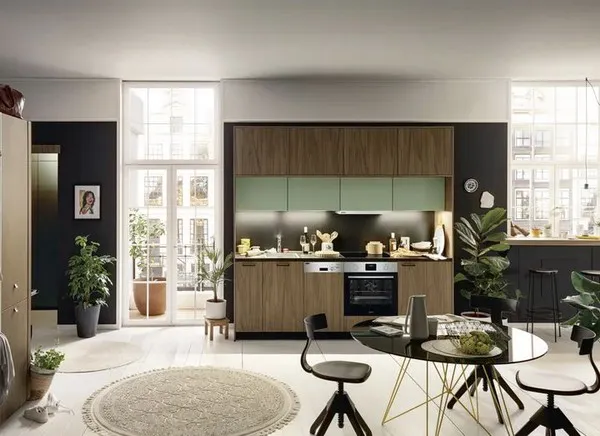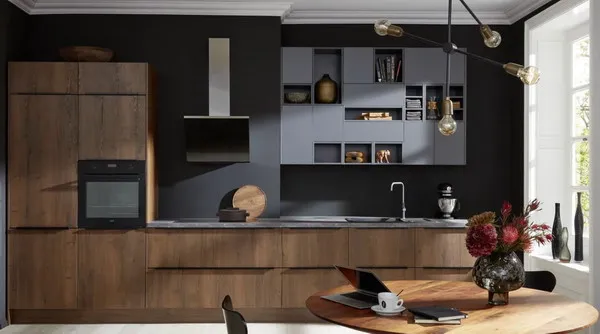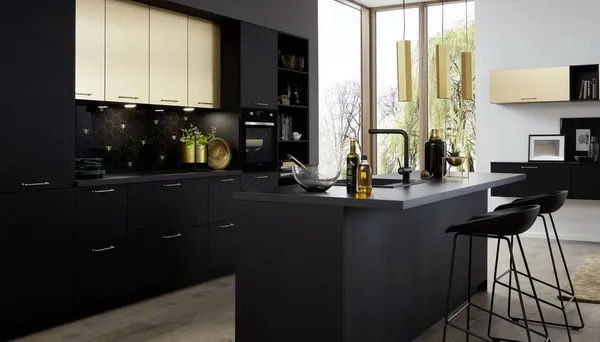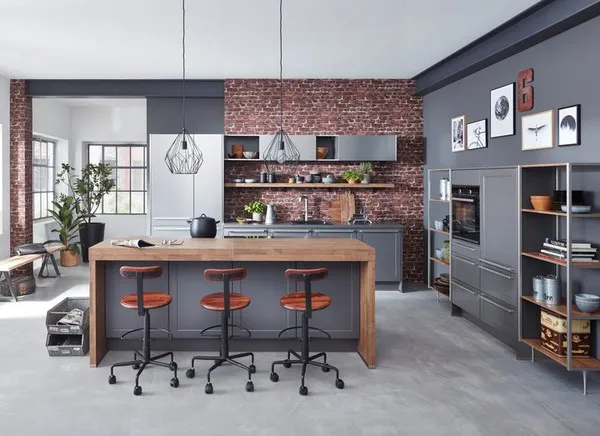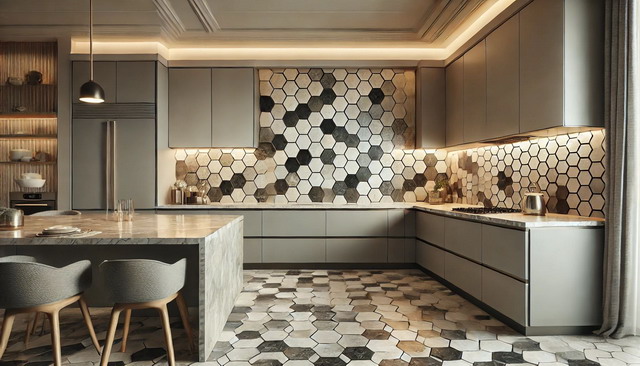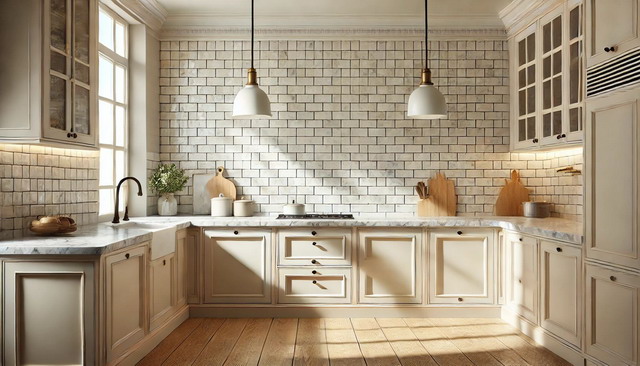Kitchen Colors 2025: Bold & Timeless Shades for a Modern Look
Last Updated on September 14, 2024 by Mutiara
The kitchen has long been regarded as the heart of the home — a place where meals are shared, conversations flow, and memories are made. As we move into 2025, kitchen design trends are evolving to reflect not only practical needs but also the emotional connection we have with this space. Central to this evolution is the growing importance of color, which has the power to shape the atmosphere, functionality, and overall aesthetic of a kitchen.
In 2025, kitchen color trends are more dynamic and diverse than ever before. From nature-inspired muted greens and blues to bold earth tones that ground the space in warmth, homeowners have more options than ever to personalize their kitchens. Pastels are making a charming comeback, adding a soft, playful touch, while dark, dramatic hues like black and charcoal are gaining popularity for their bold sophistication. Even timeless classics like warm whites and off-whites are being reimagined with new textures and finishes, offering a fresh take on a beloved palette.
But kitchen colors in 2025 aren’t just about aesthetics — they’re also about creating environments that reflect the evolving lifestyle of the modern homeowner. Whether you’re drawn to a calm, serene space or you want to make a bold design statement, the right colors can transform your kitchen into a room that feels both stylish and welcoming. In this blog post, we’ll explore the key color trends that are set to define kitchens in 2025, offering inspiration and ideas to help you create a kitchen that’s perfect for your home.
Bold Earth Tones for Kitchens in 2025
In 2025, kitchens are set to embrace a new era of boldness and warmth, with earth tones leading the charge in design trends. As more homeowners lean towards creating grounded, natural spaces that connect with the environment, earthy hues such as terracotta, clay, and rich browns are taking center stage. These colors evoke a sense of calm, stability, and comfort — exactly what’s needed in a space that serves as the heart of the home.
The Appeal of Earth Tones
One of the main reasons earth tones are gaining traction in 2025 kitchen designs is their timelessness. These shades are deeply rooted in nature, drawing inspiration from landscapes, forests, and deserts. By incorporating earthy colors into your kitchen, you’re not just following a trend; you’re opting for a palette that has long-lasting appeal.
Terracotta and clay tones, for instance, bring a rich warmth that instantly makes a kitchen feel welcoming. These colors are associated with cozy, sunbaked environments and pair beautifully with natural materials like wood, stone, and ceramics. Whether used on cabinetry, walls, or even as accents in tiles or countertops, earth tones are versatile and adaptable to various styles, from rustic farmhouse aesthetics to more modern, minimalist designs.
How to Incorporate Earth Tones in Your Kitchen
One of the best ways to bring earthy hues into your kitchen is through cabinetry. In 2025, we’re seeing a shift away from purely white or gray kitchens, as homeowners gravitate toward darker, warmer tones. Think deep brown kitchen cabinets paired with contrasting light countertops for a sophisticated and balanced look. Clay and terracotta hues can also add warmth to cabinetry, making the kitchen feel both trendy and timeless.
Another popular approach is using earth tones in the backsplash. A terracotta tile backsplash, for example, can become a focal point in the kitchen, bringing texture and color without overwhelming the space. If you’re looking for something more subtle, consider using earthy tones in the flooring. Natural stone tiles or polished concrete in warm brown or rust tones can give your kitchen a grounded, earthy vibe.
Accent pieces, such as bar stools, lighting fixtures, or small appliances in earth tones, are also an easy way to add pops of color without committing to a full remodel. These colors complement natural materials like reclaimed wood, which is also trending in 2025, enhancing the organic, nature-inspired feel.
Mixing Earth Tones with Other Colors
One of the beauties of earth tones is their ability to mix effortlessly with other colors. In 2025, designers are recommending pairing these hues with neutral tones, like soft whites, beiges, and even muted greens, to create a cohesive and tranquil environment. For example, a terracotta backsplash can be balanced with cream-colored walls or countertops for a harmonious contrast. Similarly, rich brown cabinets can be paired with light, earthy beige tones for an understated elegance.
If you’re feeling more adventurous, try pairing earth tones with deep jewel tones like emerald green or navy blue. These bolder shades add a layer of sophistication and depth, elevating the overall look of the kitchen.
Soft Neutrals with a Modern Twist
While bold earth tones make a statement, soft neutrals continue to be a strong contender in 2025 kitchen design trends. Neutrals have long been a favorite in kitchen color palettes due to their versatility and timelessness. However, this year, they are being reimagined with a modern twist, offering subtle yet impactful updates that make them anything but boring.
Why Neutrals Work in the Kitchen
Neutral tones like beige, cream, and taupe are classic choices because they provide a clean, calm canvas upon which you can build the rest of your kitchen design. These colors don’t overwhelm the space, making them ideal for kitchens where functionality and simplicity are key. Soft neutrals have the ability to make small spaces feel larger and more open, while also reflecting natural light to brighten the room.
But in 2025, these neutrals are getting a refresh. Instead of flat, one-dimensional beige, we’re seeing neutrals with depth and texture. For example, greige (a blend of gray and beige) is making waves for its sophisticated, modern appeal. It offers the warmth of beige with the cool, contemporary feel of gray, making it an ideal color for those who want a neutral kitchen that still feels fresh and on-trend.
Updating Neutrals with Texture and Contrast
One of the most exciting aspects of neutral kitchen trends in 2025 is the emphasis on texture. While the colors themselves may be soft and subtle, the textures used alongside them are anything but. To keep neutral kitchens from feeling bland, designers are incorporating materials like matte finishes, wood grains, and stone surfaces. For example, pairing cream-colored cabinets with a rough-hewn wooden island adds a tactile element that elevates the entire space.
Additionally, contrasting finishes are another way to add interest to a neutral kitchen. High-gloss surfaces combined with matte textures create a dynamic interplay of light and shadow, giving even the most minimal palette a modern edge. In 2025, expect to see kitchens that combine sleek white countertops with textured, neutral backsplashes made from natural stone or ceramic tile.
Accent Colors for Neutral Kitchens
Another way to give neutral kitchens a modern twist is by adding subtle pops of accent color. In 2025, muted tones like sage green, dusty blue, and blush pink are being used as accents to break up the neutrality and bring a sense of freshness to the space. These colors, while still soft and calming, introduce a bit of personality and playfulness to an otherwise neutral kitchen.
For example, a taupe kitchen with soft green accents on the walls or in decor items like bar stools and dishware can create a serene, nature-inspired environment. Similarly, adding a pale blue backsplash to an all-cream kitchen can offer just enough contrast to keep the space from feeling monotonous.
Neutrals as a Backdrop for Bold Elements
Finally, one of the most appealing aspects of a neutral kitchen is that it serves as the perfect backdrop for bold design elements. In 2025, we’re seeing more kitchens that pair neutral palettes with statement lighting, colorful backsplashes, and even bold artwork. The neutral tones allow these elements to shine without competing for attention, creating a balanced and cohesive look.
By embracing soft neutrals with a modern twist, homeowners can create kitchens that are both timeless and trendy. Whether you’re a fan of sleek, minimalist designs or you prefer a cozy, traditional vibe, there’s a neutral palette out there to suit your style in 2025.
Muted Greens and Blues as a Nature-Inspired Trend
In 2025, kitchen design is all about bringing the tranquility of nature indoors, and muted greens and blues are key colors in achieving this aesthetic. These calming hues are inspired by the natural world, from lush forests to serene coastlines, offering a peaceful atmosphere that transforms the kitchen into a soothing retreat.
Why Muted Greens and Blues Are Trending
After years of bright, bold colors dominating interior design, many homeowners are now looking for shades that offer serenity and a sense of calm. Muted greens and blues provide just that, creating a fresh and peaceful environment perfect for a space as essential as the kitchen. These shades feel organic, and their understated quality makes them versatile enough to work in a wide range of kitchen styles, from modern to traditional.
Greens, particularly shades like sage, olive, and eucalyptus, evoke the earthy, grounding elements of nature. They have a subtle warmth that makes them perfect for creating a cozy yet refined look. Similarly, muted blues, like dusty blue or slate, provide a cool, calming effect reminiscent of a clear sky or calm ocean. These colors are perfect for homeowners seeking a clean, minimalist space that still feels personal and inviting.
How to Incorporate Muted Greens and Blues in the Kitchen
One of the most popular ways to introduce these muted shades is through cabinetry. Sage green cabinets, for example, have become a hallmark of the nature-inspired kitchen, offering a sophisticated yet approachable alternative to the more traditional white or gray. These soft greens pair beautifully with natural wood accents, marble countertops, and matte brass hardware, creating a modern yet organic look.
For homeowners who want to take a subtler approach, muted blues can be introduced through backsplashes or walls. A dusty blue subway tile backsplash, for example, can provide a refreshing contrast to neutral or white cabinetry. Alternatively, painting kitchen walls in a soft blue or green shade can instantly transform the space into a serene oasis.
Accessories and small appliances in muted green or blue hues can also add a touch of color without overwhelming the space. Think mint green kettles, pastel blue dishware, or sage-colored bar stools. These subtle additions can tie together a cohesive look without requiring a full kitchen overhaul.
Pairing Muted Greens and Blues with Other Colors
These muted shades shine when paired with natural materials like wood and stone, which further enhance the organic feel. For example, pairing sage green cabinets with walnut countertops creates a warm, harmonious palette. Similarly, dusty blue backsplashes combined with light oak or ash wood tones bring a fresh yet grounded look to the kitchen.
Muted greens and blues also work well with other soft, neutral tones, such as warm whites, taupes, and beige. This combination creates a calming and cohesive space that feels open and airy. Additionally, you can introduce metallic accents in brushed gold or bronze to add a layer of sophistication, bringing a luxurious touch to the nature-inspired color scheme.
Dark Kitchens: Black and Charcoal in 2025
While many homeowners are gravitating toward soft, muted colors, 2025 also sees a rise in the popularity of dark, dramatic kitchens. Bold shades like black, charcoal, and deep grays are making a statement, offering a striking alternative to lighter, more neutral spaces. These dark kitchens exude sophistication, creating a moody yet elegant atmosphere that feels contemporary and luxurious.
The Appeal of Dark Kitchens
Dark kitchens are all about creating a sense of drama and depth. Black and charcoal hues have long been associated with elegance and high-end design, and they continue to trend as more homeowners seek to make a bold statement in their homes. While lighter kitchens can sometimes feel overly sterile, dark kitchens bring warmth, intimacy, and a sense of luxury to the space.
One of the reasons dark kitchens are trending in 2025 is their versatility. Black or charcoal cabinetry, for example, pairs well with a wide range of materials and finishes. Whether you prefer a sleek, modern look with glossy countertops and metallic hardware, or a more rustic feel with natural wood accents, dark kitchens can be customized to reflect personal style.
How to Make Dark Kitchens Work
The key to pulling off a dark kitchen is balance. Dark colors like black and charcoal can make a space feel heavy if not used thoughtfully, so it’s important to incorporate elements that lighten and balance the room. For example, pairing dark cabinets with lighter countertops, such as white marble or quartz, can provide contrast and prevent the space from feeling too oppressive.
Lighting is another critical element in dark kitchens. Natural light is ideal, as it helps to soften the dark hues and create a welcoming atmosphere. If your kitchen lacks natural light, consider adding pendant lighting, under-cabinet lighting, or even LED strips to brighten the space and enhance its modern appeal.
Incorporating metallic accents, like brushed brass, copper, or stainless steel, can also elevate a dark kitchen, adding a touch of glamour and contrast. These finishes provide warmth and reflect light, helping to break up the darker tones and create a more dynamic space.
Dark Colors Beyond Cabinets
While black and charcoal are popular choices for cabinetry, they can also be used in other elements of the kitchen design. Black backsplashes, for example, can add texture and depth, especially when paired with contrasting white grout. Similarly, dark kitchen islands can become a bold focal point in an otherwise neutral space, providing a visual anchor that grounds the room.
For those who prefer a more subtle approach, consider using dark colors in accent pieces, such as black faucets, handles, or light fixtures. These smaller touches can introduce the drama of a dark kitchen without committing to a full renovation.
Pastels for a Soft, Inviting Kitchen Look
Pastels are making a comeback in 2025, offering a fresh and inviting alternative to the dark and moody tones dominating kitchen design. These soft hues, such as blush pink, pale lavender, and mint green, bring a sense of whimsy and lightness to the kitchen, making them ideal for homeowners who want to create a welcoming and cheerful space.
The Rise of Pastel Kitchens
Pastels may be soft and delicate, but they’re anything but boring. In fact, pastel kitchens are becoming a favorite for those looking to add personality and charm to their homes without overwhelming the space. These lighter shades bring a playful yet sophisticated vibe, balancing modern aesthetics with a sense of nostalgia and retro-inspired charm.
In 2025, pastels are being used in a variety of kitchen elements, from cabinetry to backsplashes and even appliances. Blush pink and pale lavender, for example, can be used to create a romantic and airy atmosphere, while mint green offers a fresh and lively feel. These colors are perfect for homeowners who want to make their kitchen feel unique and full of character.
How to Use Pastels in the Kitchen
One of the most popular ways to incorporate pastels is through cabinetry. A soft pink or mint green cabinet can bring an unexpected yet delightful touch to the kitchen, creating a warm and inviting space. Pastels can also be used in backsplashes, where patterned pastel tiles add a layer of visual interest and playfulness.
If you’re not ready to commit to pastel cabinetry, consider using these colors in smaller details, such as dishware, bar stools, or light fixtures. Even small pastel appliances, like toasters or mixers, can introduce a pop of color that brightens up the kitchen without overwhelming it.
Pairing Pastels with Other Colors
Pastels work best when balanced with neutral tones or natural materials. For example, pairing pale lavender cabinets with white countertops and light wood floors can create a cohesive and calming space. Mint green backsplashes look particularly stunning when combined with white or light gray cabinetry, adding a subtle touch of color without overpowering the room.
Pastels also pair beautifully with metallic accents. Rose gold, copper, or brass finishes can add a touch of luxury to a pastel kitchen, enhancing the soft colors while adding depth and contrast. By combining pastels with these complementary materials, homeowners can create a kitchen that feels both modern and inviting.
Warm Whites and Off-Whites for Timeless Elegance
While bold colors and daring trends often capture the spotlight, warm whites and off-whites remain classic choices that continue to dominate kitchen design in 2025. These soft, subtle shades offer an air of timeless elegance that’s hard to beat, and their versatility makes them suitable for almost any kitchen style, from modern minimalist to cozy farmhouse.
The Enduring Appeal of Warm Whites
Warm whites and off-whites have been kitchen staples for decades, and for good reason. They provide a neutral foundation that allows for endless design possibilities. In 2025, we’re seeing a shift from the stark, cool whites of previous years to warmer, creamier tones that create a more inviting and homely atmosphere. These shades radiate warmth, making them ideal for kitchens where people naturally gather and socialize.
One of the reasons warm whites remain so popular is their ability to blend with any material, texture, or color palette. They serve as the perfect backdrop for both bold and understated design elements, allowing homeowners to easily refresh their kitchen by changing accents or adding new features without needing a full remodel.
How to Incorporate Warm Whites in Your Kitchen
Warm white tones are particularly well-suited for kitchen cabinets, where they create a fresh and timeless look. Whether your style leans modern or traditional, off-white cabinetry can offer a light and airy feel while still maintaining a sense of coziness. Paired with marble countertops or natural wood accents, warm whites can elevate the overall sophistication of the space.
Another popular way to use warm whites is in the backsplash or walls. A classic white subway tile with a cream undertone adds texture and depth without overwhelming the space. Additionally, painting kitchen walls in a warm white or off-white shade can help brighten the room, making it feel more open and spacious.
To keep a warm white kitchen from feeling too monochromatic, consider incorporating contrasting materials like matte black hardware, brushed brass fixtures, or even a wooden kitchen island. These elements will add visual interest while maintaining the overall warmth and elegance of the space.
Adding Texture to Warm White Kitchens
One of the biggest trends in 2025 is using texture to enhance a kitchen’s design. In a warm white kitchen, texture is essential for creating dimension and avoiding a flat, sterile look. Textured materials such as natural stone, reclaimed wood, or handmade tiles can bring warmth and character to an all-white kitchen.
For example, pairing warm white cabinets with a textured marble or quartz countertop can add a subtle yet luxurious touch. Similarly, a backsplash made of handmade ceramic tiles or natural stone with an uneven surface can introduce a layer of craftsmanship and detail that elevates the space. The key is to play with different finishes and materials to keep the kitchen feeling dynamic and inviting.
Metallic Accents in Kitchen Design
As we look ahead to 2025, metallic accents are increasingly being used to add a touch of glamour and sophistication to kitchen designs. From sleek stainless steel to warm brass and copper, metallic finishes are no longer just functional — they’ve become a statement in modern kitchen aesthetics. Whether used as subtle accents or bold focal points, metallics bring a sense of luxury and refinement to any kitchen.
Why Metallics Are Trending in 2025
One of the main reasons metallic accents are so popular in 2025 is their ability to elevate a kitchen’s overall look without overwhelming the space. Metallics, when used thoughtfully, can reflect light, add warmth, and provide an eye-catching contrast to softer tones and textures. They work particularly well in kitchens that favor neutral or minimalist color schemes, where they can stand out and create a striking visual impact.
Brass, copper, and gold finishes are especially favored this year for their ability to introduce a sense of opulence and sophistication. These warmer metallics are often used in hardware, lighting, faucets, and even range hoods to create a cohesive and polished look. In contrast, cooler metallics like stainless steel and chrome continue to dominate in modern and industrial kitchen designs, where sleek, clean lines are a priority.
How to Incorporate Metallic Accents in Your Kitchen
There are many ways to incorporate metallic finishes into your kitchen without overdoing it. One of the simplest methods is through hardware. Cabinet pulls, drawer handles, and faucets in brass, copper, or matte gold can instantly elevate the design and add a touch of luxury. These small details can make a big difference, especially when paired with complementary colors like warm whites, soft neutrals, or muted greens.
Lighting is another area where metallic finishes can shine. Pendant lights with metallic shades, for example, can serve as both functional and decorative elements, bringing warmth and character to the kitchen. Brass or copper light fixtures add a sense of sophistication, while stainless steel or chrome options provide a more modern, industrial feel.
For those looking to make a bolder statement, consider incorporating metallics in larger elements, such as a copper range hood or a stainless steel kitchen island. These features can become the focal point of the room, adding a layer of visual interest and a modern edge. Paired with softer colors and textures, these metallic elements create a balanced, harmonious look that feels both luxurious and inviting.
Pairing Metallics with Other Materials
One of the keys to successfully incorporating metallics in your kitchen is to pair them with the right materials. In 2025, we’re seeing a lot of designers mixing metallic finishes with natural elements like wood, stone, and ceramic. This combination softens the metallics’ often cold appearance, making the space feel more balanced and cohesive.
For example, brass or copper hardware pairs beautifully with wooden cabinets, adding warmth and depth to the overall design. Stainless steel appliances can be softened with a marble or stone backsplash, creating a contrast that feels both modern and inviting. The key is to blend metallics with softer, organic materials to create a look that’s both stylish and approachable.
Conclusion: Kitchen Colors in 2025 – A Balance of Boldness and Tranquility
As we move into 2025, kitchen color trends are all about balance — whether it’s combining bold earth tones with natural materials, introducing muted greens and blues for a tranquil vibe, or embracing the drama of dark kitchens with black and charcoal. There’s also room for softer palettes, as seen with the rise of pastels, and timeless options like warm whites and off-whites continue to offer a sense of timeless elegance.
For those looking to add a touch of luxury, metallic accents provide the perfect opportunity to introduce a hint of glamour and sophistication. No matter your style, 2025’s kitchen color trends offer something for everyone, allowing homeowners to experiment with different shades, textures, and materials to create spaces that are both functional and beautiful.
Ultimately, the color choices you make in your kitchen can transform not just the look of the space, but also its atmosphere and how it makes you feel. Whether you opt for the calming tones of nature, the dramatic appeal of dark hues, or the classic elegance of neutrals, the kitchen remains the heart of the home — a place where design and practicality meet to create a warm, inviting environment.
